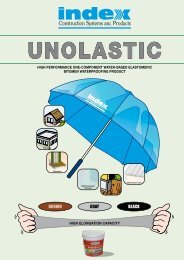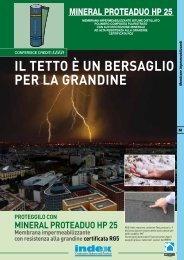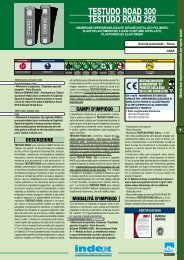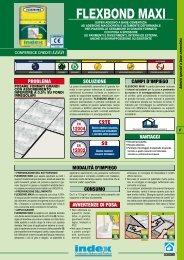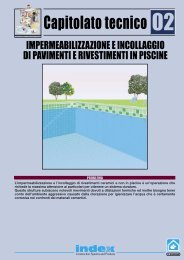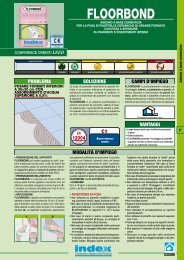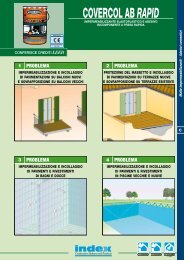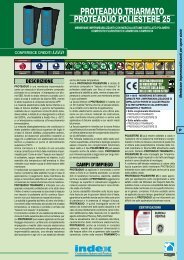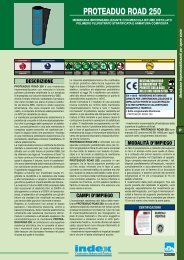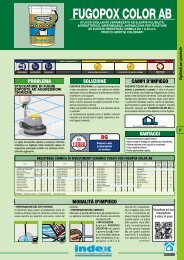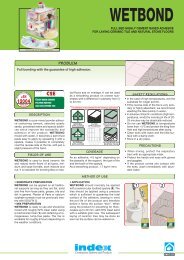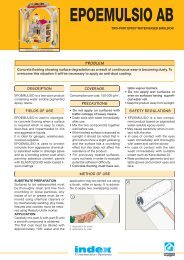guida alla posa delle membrane con adesivo a freddo - Index S.p.A.
guida alla posa delle membrane con adesivo a freddo - Index S.p.A.
guida alla posa delle membrane con adesivo a freddo - Index S.p.A.
Create successful ePaper yourself
Turn your PDF publications into a flip-book with our unique Google optimized e-Paper software.
I RIVESTIMENTO ELASTOMOERO-BITUMINOSO ALL’ACQUA<br />
GB WATER-BASED ELASTOMER/BITUMINOUS COATING<br />
D RIVESTIMENTO ELASTOMOERO-BITUMINOSO ALL’ACQUA<br />
F WATER-BASED ELASTOMER/BITUMINOUS COATING<br />
NL WATER-BASED ELASTOMER/BITUMINOUS COATING<br />
TO BE MEHANICALLY<br />
SPRAY<br />
TO BE APPLIED BY<br />
MIXED<br />
APPLICATION PLASTERING TROWEL<br />
ONE-COMPONENT<br />
WATER BASED<br />
A H 2 O<br />
MONOCOMPONENTE VEICOLO ACQUA<br />
MESCOLARE<br />
APPLICARE A<br />
MECCANICAMENTE<br />
SPRUZZO<br />
KEEP AWAY<br />
FROM FROST<br />
TO BE APPLIED TO BE APPLIED MINIMUM APPLICATION<br />
BY BRUSH<br />
BY ROLLER<br />
TEMPERATURE<br />
+ 5°C<br />
APPLICARE CON APPLICARE CON TEMPERATURA MIN.<br />
PENNELLO<br />
RULLO<br />
DI APPLICAZIONE<br />
37060 Castel d’Azzano - Verona - ITALY<br />
APPLICARE CON<br />
FRATTAZZO<br />
USE SUITABLE<br />
PROTECTION<br />
STOCCAGGIO:<br />
UTILIZZARE DISPOSITIVI<br />
TEME IL GELO DI PROTEZIONE INDIVIDUALI<br />
USO PROFESSIONALE • FOR PROFESSIONALE USE ONLY<br />
GLI ADESIVI<br />
MASTIPOL<br />
MASTIPOL è un <strong>adesivo</strong> bituminoso a base di particolari bitumi, elastomeri, solventi e cariche<br />
minerali.<br />
È formulato in modo da rendere efficace l’aderenza della membrana bitume polimero<br />
su calcestruzzo e legno, vecchi manti bituminosi, poliuretano espanso, lana di<br />
roccia e perlite espansa, quest’ultime <strong>con</strong> la faccia superiore prerivestita di bitume. Nel caso di<br />
<strong>posa</strong> su polistirolo espanso il pannello deve essere già protetto <strong>con</strong> un foglio bituminoso talcato<br />
o sabbiato <strong>con</strong> cimose che proteggano le linee di accostamento dei pannelli dalle colature<br />
dell’<strong>adesivo</strong>.<br />
Si presenta come una pasta facilmente spatolabile e si stende in modo uniforme sul piano di <strong>posa</strong><br />
usando l’apposito stenditore.<br />
Ottura le cavillature del piano di <strong>posa</strong> fornendo uno strato impermeabile intermedio fra il supporto<br />
e la membrana impermeabilizzante.<br />
MASTIPOL è impiegato per incollare le <strong>membrane</strong> bitume polimero su coperture piane di strutture civili e industriali <strong>con</strong> pendenza massima<br />
del 5%. Per pendenze superiori al 5% l’incollaggio deve essere integrato <strong>con</strong> fissaggio meccanico.<br />
Il <strong>con</strong>sumo di MASTIPOL è circa 1 kg/m 2 ca. e dipende d<strong>alla</strong> rugosità del supporto.<br />
I supporti porosi come il calcestruzzo e i vecchi manti bituminosi vanno preparati <strong>con</strong> una mano di primer bituminoso INDEVER.<br />
Le superfici di <strong>posa</strong> devono essere lisce e regolari, perfettamente pulite da parti friabili ed in distacco, asciutte ed esenti da olio e grassi.<br />
MASTIPOL non deve essere usato per incollare le sovrapposizioni della membrana e si <strong>con</strong>siglia l’applicazione a temperature del supporto<br />
superiori a +5°C.<br />
MASTIPOL<br />
Partita kg e<br />
I<br />
• CAMPI D’IMPIEGO.<br />
è <strong>con</strong>sigliato per impermeabilizzare muri di fondazione in calcestruzzo.<br />
• MODALITÁ D’IMPIEGO.<br />
La superficie da trattare deve essere asciutta, pulita e priva di parti di distacco. Le<br />
parti friabili vanno eliminate e ricostruite. Per l’adesività sulle superfici porose e<br />
secche, è <strong>con</strong>sigliabile la stesura una mano di diluita al 30% <strong>con</strong> acqua. va<br />
mescolato prima dell’uso <strong>con</strong> trapani mmani di prodotto. Non eccedere nel <strong>con</strong>sumo<br />
per mano per non l’evaporazione dell’acqua <strong>con</strong>tenuta nel prodotto applicato.<br />
• CONSUMI.<br />
0,500 kg/m 2 per mano.<br />
GB<br />
• APPLICATIONS.<br />
is recommended to waterproof foundations walls made in <strong>con</strong>crete.<br />
• DIRECTIONS.<br />
The surface to be treated has to be dry, clean and with no detaching parts. Weak<br />
parts have to be eliminated and replaced with new material. In order to improve<br />
the adhesive onto porous and dry surfaces, it is recommended to previously spread<br />
a first layer <strong>con</strong>sisting in a 30% water-diluted . has to be mixed before use with<br />
mechanic drills. Application can be made with brushes, rollers or spraying devices.<br />
• CONSUMPTION.<br />
0.5 kg/square metre/year.<br />
D<br />
• APPLICATIONS.<br />
is recommended to waterproof foundations walls made in <strong>con</strong>crete.<br />
• DIRECTIONS.<br />
The surface to be treated has to be dry, clean and with no detaching parts. Weak<br />
parts have to be eliminated and replaced with new material. In order to improve<br />
the adhesive onto porous and dry surfaces, it is recommended to previously spread<br />
a first layer <strong>con</strong>sisting in a 30% water-diluted . has to be mixed before use with<br />
mechanic drills. Application can be made with brushes, rollers or spraying devices.<br />
• CONSUMPTION.<br />
0.5 kg/square metre/year.<br />
F<br />
• APPLICATIONS.<br />
is recommended to waterproof foundations walls made in <strong>con</strong>crete.<br />
• DIRECTIONS.<br />
The surface to be treated has to be dry, clean and with no detaching parts. Weak<br />
parts have to be eliminated and replaced with new material. In order to improve<br />
the adhesive onto porous and dry surfaces, it is recommended to previously spread<br />
a first layer <strong>con</strong>sisting in a 30% water-diluted . has to be mixed before use with<br />
mechanic drills. Application can be made with brushes, rollers or spraying devices.<br />
• CONSUMPTION.<br />
0.5 kg/square metre/year.<br />
NL<br />
• APPLICATIONS.<br />
is recommended to waterproof foundations walls made in <strong>con</strong>crete.<br />
• DIRECTIONS.<br />
The surface to be treated has to be dry, clean and with no detaching parts. Weak<br />
parts have to be eliminated and replaced with new material. In order to improve<br />
the adhesive onto porous and dry surfaces, it is recommended to previously spread<br />
a first layer <strong>con</strong>sisting in a 30% water-diluted . has to be mixed before use with<br />
mechanic drills. Application can be made with brushes, rollers or spraying devices.<br />
• CONSUMPTION.<br />
0.5 kg/square metre/year.<br />
POSA A FREDDO SU CALCESTRUZZO POSA A FREDDO SU LEGNO POSA A FREDDO SU ISOLANTE TERMICO<br />
MASTIPOL<br />
MASTIPOL<br />
MASTIPOL<br />
CARATTERISTICHE TECNICHE<br />
MASTIPOL<br />
Aspetto<br />
pastoso<br />
Colore<br />
Nero<br />
Peso specifico massa volumica<br />
a 23°C (UNI-EN-ISO 2811-1)<br />
1,30±0,10 kg/litro<br />
Residuo secco (m/m)<br />
(UNI-EN-ISO 3251) 80%±4%<br />
Viscosità <strong>con</strong> coppa Ford<br />
n. 6 a 23°C (UNI-EN-ISO 2431) 20’±3’<br />
Punto di infiammabilità<br />
(vaso chiuso) (ASTM D 3828-87)<br />
>23°C<br />
Stoccaggio nelle <strong>con</strong>fezioni originali<br />
12 mesi<br />
4 GUIDA ALLA POSA DELLE MEMBRANE CON ADESIVO A FREDDO





